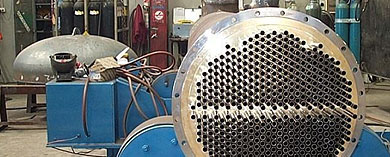
- (03) 5909 8218
- enquiry@fusionweld.com.au
Stress and Strain Analysis on Circular Cylinders for Pressure Vessels
May 30, 2016

Cylindrical outlines have established dominance over our chemical and fuel storage installations. These fluid storage vessels are manufactured from gargantuan sheets of rolled steel and formed into circular cylinders with rounded end caps. Exhaustively tested to ensure each rolled edge and welded seam complies with international engineering standards, passive testing procedures assess the pressure vessels for potential microcrystalline defects. Still, as stringent as this testing phase is, it isn't enough to satisfy an in-compliance design and commission grading process, not when the vessel in question will soon be exposed to near unimaginable pressures.
Dynamic Assessment
A dynamic analysis process assesses the circular cylinders and determines whether the unified structure can function safely within its specified application domain. The procedure is based on simple dimensional constants, the area of the metal, thickness, its volumetric capacity, and so on. But the engineering mathematics in play here quickly escalate to accommodate complex variables, including the viscosity of the fluid, all constant-level pressure variable, and any transient spikes present in the processing chain.
Stresses accounted for include:
- Radial stress
- Longitudinal strain
- Hoop pressure
- Transient loads
Theoretically Assessed
As design workshops aren't about to load every product they make with thousands of cubic litres of pressurized fluids, we turn again to the theoretical realm. Engineering equations account for fluid forces while static equilibrium analysis documents the effects of normal stresses. Computer-simulated studies allow engineers to plug in these constants and the countless variables that play out as soon as fluids enter the scene.
Practical Testing Disciplines
Strain gauges are part of the test environment when pressure vessels are assessed, as are pressure detecting instruments and temperature measurement devices. The quantified strain data is employed as a key part of the study, with other data acquisition methods contributing to a comprehensively detailed causal relationship guide, one that gathers all data under the stress and strain analysis umbrella. Once assessed, the data is instantly on hand for comparative studies, cases where identically fabricated pressure vessels can be compared against each other.
As circular cylinders are a composite, a blending of spheres and cylinders, the mathematics used to quantify possible defects can get complicated, but computer simulations simplify much of this work, which leads to a fast and productive commissioning stage. Still, there are many other real world factors to consider, including but not limited to wear, uneven loading, and the heat produced by boilers or other heat exchanging mechanisms.
Contact Details
Fusion - Weld Engineering Pty Ltd
ABN 98 068 987619
1865 Frankston Flinders Road,
Hastings, VIC 3915
Ph: (03) 5909 8218
Optimized by NetwizardSEO.com.au
Recent Posts
- Scheduling Periodic Laundry Boiler Inspections: Best Practices for Plant Managers
- Glycol Regeneration Units - Manufacturing to Optimise Natural Gas Processing
- Skid Mounted Systems for Oil and Gas Industries: Achieve Mobility and Flexibility
- The Role of Transportable Pressure Vessel Inspections in Ensuring Safety
- Periodic Tank In-Service Inspection: How It Maintains Bulk Storage Tank Integrity
- Static Pressure Vessel Manufacturing: Achieve Maximum Reliability
- Pressure Equipment Management by Fusion-Weld: Key Role in Industrial Safety
- Pressure Piping System Inspection: A Gift of Safety for the Holidays
- Deaerator Inspections by Fusion-Weld Engineering and How They Reduce System Downtime
- Bulk Storage Tank Inspection: Protecting Your Essential Assets
- Pipe Spooling Design and Manufacture: Ensuring Accuracy and Fit
Posts 2023
- Pressure Piping System Inspection: A Gift of Safety for the Holidays
- Deaerator Inspections by Fusion-Weld Engineering and How They Reduce System Downtime
- View all articles…
Posts 2022
- How Fusion Weld Keeps Up With AS-NZS ISO 9001:2008 Standard
- Boiler Equipment Safety Inspection During the Summer Season
- View all articles…
Posts 2021
- Avoid These Factors and Practices that Contribute to Sealing Damage in Pressure Vessels
- Do's And Don'ts Of Industrial Boiler Inspection And Maintenance From Fusion-Weld
- View all articles…
Posts 2020
- What are the Risks and Hazards Involved in Pressure Vessel Equipment?
- How to Know if Your Pressure Equipment Needs Repair or Replacement?
- View all articles…
Posts 2019
- Factors that Contribute to Pressure Vessel Failure
- Pressure Vessel Regulations in Australia: What are the Mandatory Requirements?
- View all articles…
Posts 2018
- Pros and Cons of Spherical vs. Cylindrical Pressure Vessels
- What are the Different Hazard Levels in Pressure Vessels?
- View all articles…
Posts 2017
- Transportable Pressure Vessels: The Importance of Inspection and Safety Checks
- Fracture Mechanics and Stress Analysis of Cracks in Pressure Vessels
- View all articles…
Posts 2016
Posts 2015
- What Are Deaerators & Feedwater Vessels?
- Precautions and Safety for Compressed Air Receiver Vessels
- View all articles…
Posts 2014
- Demonstrating In-process Inspection Procedures
- Static Grounding Practices and Standards
- View all articles…